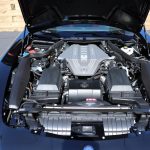Growing up with a family heritage of exemplary achievement is immensely stressful. The constant pressure to succeed and surpass parents, grandparents, and extended family can be enough to break even the strongest wills. In this 21st century, many iconic cars from automotive history have received a revival or continuation which experienced that pressure. Several of them floundered and failed miserably despite their roots. However, one of the descendants of automotive royalty has demonstrated that their genetic makeup is exclusively the best parts of their ancestry. The SLS AMG, descended from the most prestigious racing cars-turned status symbols, has done more than look the part to fill the shoes of its forefathers; it is their magnum opus
With a heritage like the one carried by the SLS AMG, recognizing what makes it such a special car involves looking back at the resumes of its family tree. The elongated hood, curvaceously sculpted body lines, and distinctive gull-wing doors were directly inspired by one of the most unique race cars to experience success during a golden age of motorsports. Today, the SLS AMG is considered a supercar and recognized as one of the understated greats among its competitors. Its incredible performance packaged in comfortable luxury is an expectation of Mercedes now, which it arguably surpassed, but were not always the status quo in a touring Benz. The SLS came from humble beginnings that would be an immediately timeless success upon their debut to the world. Thankfully, the dedicated efforts of some now famous enthusiasts developed two cars that would eventually beget the SLS AMG and lay the foundation for what we have come to expect from one of the foremost manufacturers of fine automobiles.
In the wake of World War II, the Daimler-Benz facilities were all but mountains of rubble. In a few short years, those piles of rock and debris were restored and able to churn out a post-war series of cars that would define the theme of Mercedes designs for over sixty years. More interesting, though, was the creation of a space frame racing car by the chief developing engineer, Rudolf Uhlenhaut. This frame, which encased the driver in a cocoon of scaffolding, was light, sturdy, and well balanced. Oddly, as a result of its high side tubing, the finished product could not use traditionally functioning doors. The regulations to which the car was held for racing demanded that all cars have doors that did open. In a moment of German creativity, Uhlenhaut made a decision that would become the defining feature of a legendary series of cars. The gull-wing doors on which he settled offered a perfect solution then, and are a symbol of success now. Miraculously, the car was ready for its first performance at the Mille Miglia for the 1952 Sportscar Racing season, just seven short years after the plant from which it left could have been swept away with a broom.
From that racing car, dubbed the W194, an American saw a potential for the German coupé to succeed somewhere besides the 24 Hours of Le Mans or the Nürburgring. Max Hoffman, the sole importer of Mercedes vehicles to the United States, lobbied to the executives in Stuttgart and eventually managed to convince them to produce the road-going sister to the race car with funky doors. The W198 300SL, a monument to luxury, performance, and cutting-edge technology, stole the show for its debut at the New York auto convention in 1954.
The W198 300SL brought with it the same frame with an aerodynamic body, long hood, short rear deck, and of course, gull-wing doors. Several technological advancements made by the Mercedes-Benz team were also automotive firsts, which made the 300SL the peak of vehicular performance in 1954 and the years that followed. Its independent suspension gave the car incredible handling characteristics while its tight steering allowed for precise driving. Paired with its highly mechanical four-speed gearbox, the gull-wing was both engaging to drive and easy to use as a regular mode of transportation. As for the engine, the straight-six no longer sported carburetors but instead used the first form of direct gasoline fuel injection ever in a production car. The dependability and performance of that engine, which would carry the 300SL to a blistering 150mph top speed, was nearly as definable to the car as its quirky doors.
The futuristic and forward-thinking design of the 300SL allowed it to remain relevant and completely overshadow its ‘successors’ that followed after the gull-wing was discontinued in 1963. Its advanced features and performance kept it ahead of anything else with similar capabilities but none of the style. The following model to receive the same 300SL name just couldn’t hope to carry the panache that the thoroughbred W198 boasted. It would not be until the AMG division decided it was time to revive the legendary classic that the world would see another like the W198.
At the Frankfurt Motor Show in 2009, Mercedes reintroduced the beautiful shape of a long hood, short rear deck, and sculpted body that greeted onlookers with open gull-wing doors. The SLS AMG, or Super Leicht Sport, was instantly recognized as more than just the progeny that could fulfill the dreams of its father. This car was original in its sleek design and a distinctly true to its heritage simultaneously. It was more than a tribute; it was a full reunion tour with a surprise new album all wrapped up in its monstrously powerful 6.2 liter V8 and encased in the luxury of leather and aluminum.
The SLS AMG still has the jutting front end from the old W198, which sports a beautifully aggressive pair of headlights and massive Tri-Star fitted to its gaping maw. Looks alone do not a proper sports car make, however. Part of what made its ancestors incredible to drive and competitive anywhere was the light frame and amazing weight distribution. Switching from a straight-six to a massive V8 sounds like the muscle car ‘slap a bigger engine in it and call it good’ bit of behavior. This, however, is Mercedes’ top-of-the-line car, and the first ever designed entirely by AMG. The SLS boasts a 47 percent to 53 percent weight balance front to rear thanks to the placement of its sizable V8 well behind the front axles. Even the starship-stopping brake calipers are oriented to the middle of the car to help pull the axis of rotation directly beneath the driver. Its lightweight spirit is genetically derived from the winning formula originally developed by Uhlenhaut but with a sense of modernity and exclusivity that was impossible in the middle of the 20th century.
Years of advancements in technology were required before something like the SLS could be built to meet the same relative success and unique personality that belonged to the 300SL. It is, in every regard, the true heir to the gull-wing name and doors. This is not built just for appearance's sake with the same sixty-year-old technology like some of the retro-throwback cars of the last decade. The SLS AMG performs above and beyond its competitors thanks to the same attitude that allowed it to do so in 1955. Fortunately, it still carries the poised grace only a Mercedes coupé could while shocking its occupants with dramatic acceleration and handling.
The stately appearances with hints to its motorsport roots continue into the interior, which also feels reminiscent to the 300SL. In Classic Red, the seats, door cards, armrest, and various bits of stitching remind drivers of the luxurious cabin found in its predecessor. Everything that isn’t covered in Alcantara or leather is cold aluminum, a reference to the aluminum bodies of its rarest ancestors, and a contemporary industrial interior design choice that sets the occupants in an environment clearly built by craftsmen. Even the circular air vents feel mechanical and old-school in their articulation and form but refuse to detract from the interior as gimmicky.
The orientation of all switches, buttons, and necessary information for the driver are centered around their seat. The ergonomic interior and surprising headroom speak to the logic and thoughtfulness of the designers while feeling distinctly related to the original simplicity of the W198. Although the steering wheel is not white, nor does it tilt on an unconventional mechanism for easier ingress and egress, it still offers a motorsport-inspired feel in both its shape and the sections of Alcantara where the driver’s hands should sit in their proper positions. It isn’t without the creature comforts one would expect in a price segment such as the one this Benz finds itself. The display screen, paddle shifters, reverse camera, sensors, multiple driving modes, and a litany of other accessories give the SLS AMG the same surprising amount of technology that stunned buyers in 1955 with the advancements in the 300SL.
Sitting there in the tight but comfortable cabin of the SLS AMG is inspiring, but not nearly as intoxicating as the sound upon startup. With a press of the illuminated Engine Start button on the center console, the 563hp M159 V8 emits an angelic chorus of throaty crackles as it roars to life. The sound, shape, and quirky method of access to the SLS AMG give the driver a sense that they are, in fact, piloting a weapon of laser precision and terrible destruction, even sitting still. At no point does the car feel big, heavy, or remotely related to any of its contemporary Mercedes cousins. True to its roots, the lightweight car is built for performance, driving excellence, supreme luxury, and demonstrates an ability to be understated in its achievements.
The SLS AMG is a rare combination indeed. It is the favorite child from wealthy roots who is nothing but kind to everyone without showing off in a flashy manner, despite its snarling V8 and overhead opening doors. It is a star athlete with a nearly perfect report card, but you will never hear it boast. Not like its Ferrari and Lamborghini competitors who sport vibrant color schemes, rear-engine layouts, and demand the attention of everyone they pass. The SLS AMG slides into the mundane world of standard commuters with its understated posture rather than lord over them with a gaudy flashiness. It offers an appearance that any respectable businessman could be seen driving without anyone assuming they recently scored big on a lottery ticket. The SLS AMG represents its pedigree with humility and excellence.
The SLS AMG mirrored its 300SL inspiration in appearance, performance, and presence. Sadly, as all good things must, the production run ended in 2014 to once again give way to a less successful younger sibling. The gull-wing coupe, it seems, is a genetic anomaly that only appears once in a lifetime. Like its ancestors, the SLS AMG is already a collector’s dream of a car. With its racing history, unforgettable design, and eye-widening performance, the SLS AMG is the pride of its ancestry who, sixty years ago, provided the same feeling to enthusiasts that the new generation of Mercedes-Benz drivers can now appreciate with the spiritual successor to that pinnacle of achievement. Hopefully, it won’t take the AMG division another sixty years to recreate that same hair-raising feeling of electricity that one finds in the SLS AMG.







